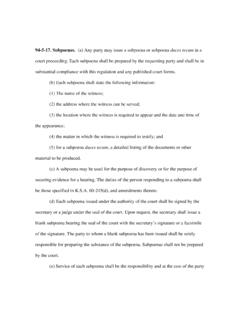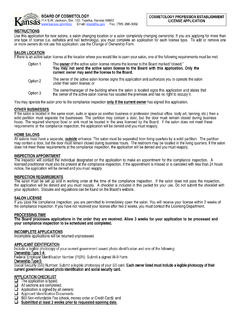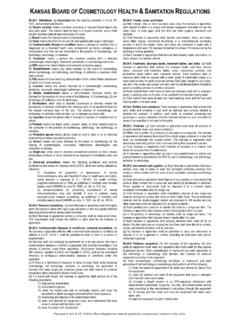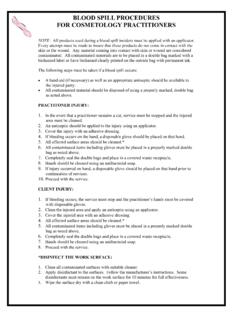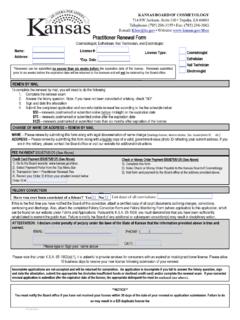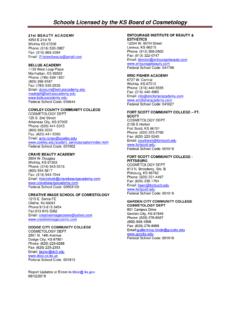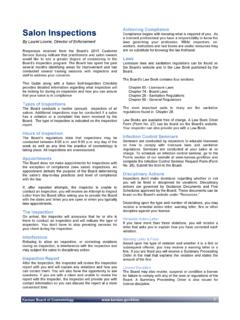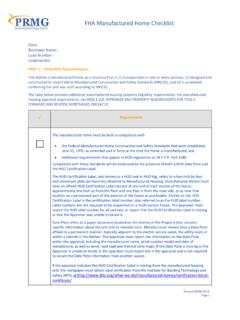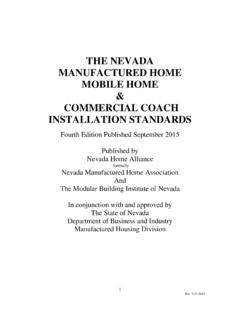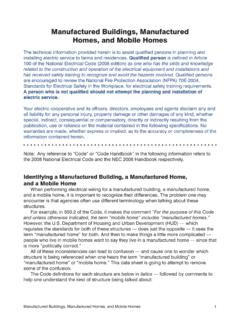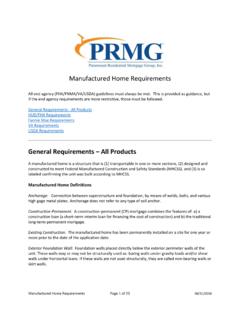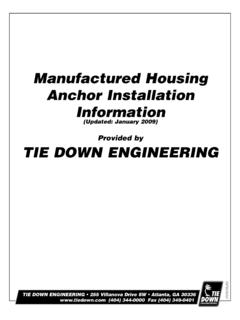Transcription of Appraisal of Manufactured Housing - Kansas.gov
1 Appraisal OF Manufactured Housing . RESEARCHED AND WRITTEN FOR THE ALABAMA REAL ESTATE APPRAISERS BOARD. It has come to the attention of the Board through numerous inquiries from our licensees that there is some confusion surrounding a number of issues related to the Appraisal of Manufactured Housing properties in Alabama. The majority of inquiries relate to distinctions between real estate and personal property, proper Appraisal methodology, use of land/home packages as comparable sales, and general USPAP compliance issues. Based on comments from licensees as well as Manufactured Housing dealers and lenders, it is apparent that many appraisers are either hesitant or unwilling to accept Appraisal assignments involving Manufactured Housing .
2 From an appraiser's viewpoint, the idea that Manufactured Housing permanently located on a parcel of land can be valued in similar fashion to a site built structure is a relatively new concept. Many appraisers have indicated they decline assignments to appraise Manufactured Housing because they lack the knowledge and experience to perform the assignment competently. Other impediments cited by licensees include conflicting governmental regulations, overly restrictive underwriting guidelines, and the inability to obtain legitimate comparable sales data. In our discussion with other state Appraisal regulatory agencies, we have found that these issues are not unique to Alabama. The term Manufactured Home is not to be confused with other types of factory built Housing such as Modular Homes, Panelized Homes, and Pre-Cut Homes.
3 Today, all Manufactured homes are built under the federal building code administered by the Department of Housing and Urban Development (HUD). Generally speaking, a Manufactured home is one that is structurally complete before leaving the factory, and is transported in one or more sections on an attached undercarriage. Manufactured homes are built on steel frames ( I beams) with a tongue and are mounted on axles and wheels for transport. On June 15, 1976, the Federal Mobile Home Safety and Construction Standards Act was enacted by Congress to ensure that minimum standards of construction established by the federal government were applied across the industry. Prior to this time, mobile homes were built using a variety of standards established by individual manufacturers and state building codes with little consistency as to quality of construction or safety considerations.
4 All mobile or Manufactured home units constructed after June 15, 1976 must have the red metal HUD label certifying that it has been inspected in accordance with the requirements of HUD and constructed in conformance with the Federal Mobile Home Safety and Construction Standards Act. On October 8, 1980 public law 96-399 was enacted by the Congress officially changing the name from mobile home to Manufactured home.. When appraising a Manufactured home property, it is imperative that the appraiser make every effort to identify the ultimate user of the Appraisal because there are a myriad of Supplemental Standards imposed by conventional lenders, Fannie Mae, and HUD. Appraisers must comply with these supplemental standards in addition to the applicable standards set out in USPAP.
5 HUD's Appraisal standards are very comprehensive and can be viewed and downloaded from their internet web site ( ). Fannie Mae's criteria for Manufactured Housing Appraisal can be obtained from Fannie Mae approved lenders. In Manufactured Housing Appraisal , the most critical factor to be determined is whether the Manufactured home is to be appraised as personal property or real property. Real estate (or real property). as defined in the 2001 edition of USPAP is an identified parcel or tract of land, including improvements, if any. The Courts have generally held that an article in the nature of personal property which has been so annexed to the realty that it is regarded as a part of the land becomes real property.
6 Manufactured Housing , which by nature is personal property, must therefore be permanently affixed to the land in order to be appraised as real estate (or real property). Manufactured homes not permanently affixed to the land must be appraised as personal property. In the absence of well defined guidelines that identify the criteria necessary to meet the standard of permanently affixed, the Board takes the position that the minimum requirements which must be met include: removal of the tongue, axles, and wheels; tie-downs must be installed; appraiser must be of the opinion the intent is for Manufactured home to be permanently attached to the land; homeowner must surrender title to the appropriate revenue commission and take whatever steps are necessary to have the Manufactured home assessed as real estate.
7 If the appraiser determines that the Manufactured home is permanently affixed to the land, the Appraisal can be developed and reported on the Form URAR 1004 in compliance with Standards 1 and 2 of USPAP and any Supplemental Standards that may be imposed by the client. If the Appraisal assignment involves a Manufactured home that has yet to be sited but is to be permanently affixed as real property, the Appraisal should be developed in conformance with USPAP Standard 1-4(h) for proposed construction. The Cost Approach should be developed using data from generally accepted cost data sources such as Marshall & Swift that provide cost data not only for the Manufactured Housing unit, but also the permanent foundation costs and site improvement costs.
8 When appraising a Manufactured home as a component of the real estate, the Sales Comparison Analysis can only be developed using open market, arms-length transactions of similarly sited Manufactured home properties. Land/home packages are not appropriate for use in the Sales Comparison Approach since the property, as a whole, has not been exposed to the market for a reasonable period of time. In its simplest term, a land/home package is the sum total of the dealer-financed purchase price of a new or used Manufactured home off the dealer's lot and the price paid for the land. When appraisers either wittingly or unwittingly attempt to pass off a land/home package as a comparable sale, the information source has typically been found to be a HUD-1 closing statement provided by the dealer.
9 Custom-build contracts are the site-built home counterparts to Manufactured home land/home packages and are not acceptable for use a comparable sales in Appraisal of site-built homes. If there are no Manufactured Housing sales within close proximity to the subject, Fannie Mae and HUD allow for an expanded search radius. Although Fannie Mae and HUD do not specify how far the search radius can be expanded, proper Appraisal practices dictate that the sales be located in a competitive market area. Unfortunately, many conventional lenders have unrealistic or overly restrictive proximity guidelines for comparable sales data. As a last resort when no market sales or similarly sited Manufactured home properties are available, Fannie Mae and HUD allow the use of site-built homes as comparable sales.
10 If forced to use site-built properties as comparables, the appraiser must explain and support the reason for their use and make appropriate and justifiable adjustments for size, site, construction quality, utility, etc. As a word of warning, the Board cautions all appraisers that, before using sales of site-built properties as comparables, a diligent search of all potential sources of comparable sales data for Manufactured Housing properties must be made and documented in the report and work file. The search must not be limited only to traditional data sources such as MLS, but should include other resources including but not limited to tax assessor/collector offices, probate records, real estate agencies, appraisers, and developers.

